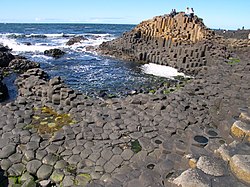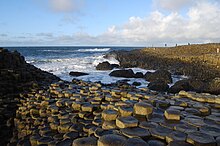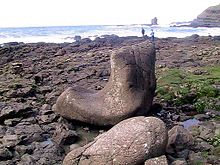Giant's Causeway
| Giant's Causeway and Causeway Coast | |
|---|---|
| Native names Irish: Clochán an Aifir/Clochán na bhFomhórach[1] Scots: Tha Giant's Causey[2] |
|

The Giant's Causeway
|
|
| Location | County Antrim |
| Coordinates | 55°14′27″N 6°30′42″W / 55.24083°N 6.51167°WCoordinates: 55°14′27″N 6°30′42″W / 55.24083°N 6.51167°W |
| Official name: the Giant's Causeway and Causeway Coast | |
| Type | Natural |
| Criteria | VII, VIII |
| Designated | 1986 (10th session) |
| Reference no. | 369 |
| State Party | |
| Region | Europe |
The Giant's Causeway is an area of about 40,000 interlocking basalt columns, the result of an ancient volcanic eruption.[3][4] It is located in County Antrim on the north coast of Northern Ireland, about three miles (4.8 km) northeast of the town of Bushmills.
It was declared a World Heritage Site by UNESCO in 1986, and a national nature reserve in 1987 by the Department of the Environment for Northern Ireland. In a 2005 poll of Radio Times readers, the Giant's Causeway was named as the fourth greatest natural wonder in the United Kingdom.[5] The tops of the columns form stepping stones that lead from the cliff foot and disappear under the sea. Most of the columns are hexagonal, although there are also some with four, five, seven or eight sides. The tallest are about 12 metres (39 ft) high, and the solidified lava in the cliffs is 28 metres (92 ft) thick in places.
Much of the Giant's Causeway and Causeway Coast World Heritage Site is today owned and managed by the National Trust and it is one of the most popular tourist attractions in Northern Ireland.[6] The remainder of the site is owned by the Crown Estate and a number of private landowners.
Contents
Geology[edit]
Around 50 to 60 million years ago,[3] during the Paleocene Epoch, Antrim was subject to intense volcanic activity, when highly fluid molten basalt intruded through chalk beds to form an extensive lava plateau. As the lava cooled, contraction occurred. Horizontal contraction fractured in a similar way to drying mud, with the cracks propagating down as the mass cooled, leaving pillarlike structures, which are also fractured horizontally into "biscuits". In many cases the horizontal fracture has resulted in a bottom face that is convex while the upper face of the lower segment is concave, producing what are called "ball and socket" joints. The size of the columns is primarily determined by the speed at which lava from a volcanic eruption cools.[7] The extensive fracture network produced the distinctive columns seen today. The basalts were originally part of a great volcanic plateau called the Thulean Plateau which formed during the Paleocene.[8]
Legend[edit]
According to legend, the columns are the remains of a causeway built by a giant. The story goes that the Irish giant Fionn mac Cumhaill (Finn MacCool), from the Fenian Cycle of Gaelic mythology, was challenged to a fight by the Scottish giant Benandonner. Fionn accepted the challenge and built the causeway across the North Channel so that the two giants could meet. In one version of the story, Fionn defeats Benandonner.[9] In another, Fionn hides from Benandonner when he realises that his foe is much bigger than he is. Fionn's wife, Oonagh, disguises Fionn as a baby and tucks him in a cradle. When Benandonner sees the size of the 'baby', he reckons that its father, Fionn, must be a giant among giants. He flees back to Scotland in fright, destroying the causeway behind him so that Fionn would be unable to chase him down.[10] Across the sea, there are identical basalt columns (a part of the same ancient lava flow) at Fingal's Cave on the Scottish isle of Staffa, and it is possible that the story was influenced by this.[11]
In overall Irish mythology, Fionn mac Cumhaill is not a giant but a hero with supernatural abilities. In Fairy and Folk Tales of the Irish Peasantry (1888) it is noted that, over time, "the pagan gods of Ireland [...] grew smaller and smaller in the popular imagination, until they turned into the fairies; the pagan heroes grew bigger and bigger, until they turned into the giants".[12] There are no surviving pre-Christian stories about the Giant's Causeway, but it may have originally been associated with the Fomorians (Fomhóraigh);[13] the Irish name Clochán na bhFomhóraigh or Clochán na bhFomhórach means "stepping stones of the Fomhóraigh". The Fomhóraigh are a race of supernatural beings in Irish mythology who were sometimes described as giants and who may have originally been part of a pre-Christian pantheon.[14]
Tourism[edit]
The discovery of the Giant's Causeway is attributed to the Bishop of Derry who had visited the site in 1692. The existence of the site was announced to the wider world the following year by the presentation of a paper to the Royal Society from Sir Richard Bulkeley, a fellow of Trinity College, Dublin. The Giant's Causeway received international attention when Dublin artist Susanna Drury made watercolour paintings of it in 1739; they won Drury the first award presented by the Royal Dublin Society in 1740 and were engraved in 1743.[15] In 1765 an entry on the Causeway appeared in volume 12 of the French Encyclopédie, which was informed by the engravings of Drury's work; the engraving of the "East Prospect" itself appeared in a 1768 volume of plates published for the Encyclopédie.[16] In the caption to the plates French geologist Nicolas Desmarest suggested, for the first time in print, that such structures were volcanic in origin.
The site first became popular with tourists during the nineteenth century, particularly after the opening of the Giant's Causeway Tramway, and only after the National Trust took over its care in the 1960s were some of the vestiges of commercialism removed. Visitors can walk over the basalt columns which are at the edge of the sea, a half-mile walk from the entrance to the site.
Visitors' centre[edit]
The Causeway was without a permanent visitors' centre between 2000 and 2012, as the previous building, built in 1986, burned down in 2000.[17] Public money was set aside to construct a new centre and, following an architectural competition, a proposal was accepted to build a new centre, designed by Dublin architectural practice Heneghan Peng, which was to be set into the ground to reduce impact to the landscape. A privately financed proposal was given preliminary approval in 2007 by the Environment Minister and DUP member Arlene Foster.[18] However, the public money that had been allocated was frozen as a disagreement developed about the relationship between the private developer Seymour Sweeney and the DUP.[19] It was also debated whether a private interest should be permitted to benefit from the site – given its cultural and economic importance and as it is largely owned by the National Trust. Coleraine Borough Council voted against the private plans and in favour of a public development project,[20] and Moyle District Council similarly signalled its displeasure and gave the land on which the previous visitors' centre stood to the National Trust. This gave the Trust control of both the Causeway and surrounding land. Ultimately Mr. Sweeney dropped a legal challenge to the publicly funded plan.[21] In 2007, the Giant's Causeway visitor centre was awarded with a National Award of Excellence for 'Best Tour Visit' by CIE Tours International, for the 5th consecutive year.[22]
The new visitor centre was officially opened by First Minister Peter Robinson and Deputy First Minister Martin McGuinness in July 2012,[23] with funding having been raised from the National Trust, the Northern Ireland Tourist Board, the Heritage Lottery Fund and public donations.[24] Since opening, the new visitor centre has garnered very mixed reviews from those visiting the Causeway for its pricing, design, contents and placement across the causeway walk descent.[25]
There was some controversy regarding the content of some exhibits in the visitor centre, which refer to the Young Earth Creationist view of the age of the Earth.[26][27] While these inclusions were welcomed by the chairman of the Northern Irish evangelical group, the Caleb Foundation,[28] the National Trust stated that the inclusions formed only a small part of the exhibition and that the Trust "fully supports the scientific explanation for the creation of the stones 60 million years ago."[29] An online campaign to remove creationist material was launched in 2012, and following this, the Trust carried out a review and concluded that they should be amended to have the scientific explanation on the causeway's origin as their primary emphasis. Creationist explanations are still mentioned, but presented as a traditional belief of some religious communities rather than a competing explanation for the causeway's origins.[30]
Notable features[edit]
Some of the structures in the area, having been subject to several million years of weathering, resemble objects, such as the Organ and Giant's Boot structures. Other features include many reddish, weathered low columns known as Giants Eyes, created by the displacement of basalt boulders; the Shepherd's Steps; the Honeycomb; the Giant's Harp; the Chimney Stacks; the Giant's Gate and the Camel's Hump.
Flora and fauna[edit]
The area is a haven for seabirds such as fulmar, petrel, cormorant, shag, redshank, guillemot and razorbill, while the weathered rock formations host a number of plants including sea spleenwort, hare's-foot trefoil, vernal squill, sea fescue and frog orchid.
A stromatolite colony was reportedly found at the Giants Causeway in October 2011 – an unusual find, as stromatolites are more commonly found in warmer waters with higher saline content than that found at the causeway.[31]
Similar structures[edit]
Although the basaltic columns of the Giant's Causeway are impressive, they are not unique. Basalt columns are a common volcanic feature, and they occur on many scales (because faster cooling produces smaller columns).
Railway access[edit]
The Belfast-Derry railway line run by Northern Ireland Railways connects to Coleraine and along the Coleraine-Portrush branch line to Portrush. Local Ulsterbus provide connections to the railway stations. There is a scenic walk of 7 miles from Portrush alongside Dunluce Castle and the Giant's Causeway and Bushmills Railway.
References[edit]
- ^ "Clochán an Aifir / Giant's Causeway - Placenames Database of Ireland". Placenames Commission. Retrieved 8 September 2014.
- ^ The Crack: Yin giant step for mankind The News Letter. Retrieved 16 October 2011.
- ^ a b "Giant's Causeway and Causeway Coast". UNESCO World Heritage Centre. Retrieved 21 June 2009.
- ^ Jack Challoner, John Farndon, Rodney Walshaw (2004). Rocks, Minerals and the Changing Earth. Southwater. p. 19.
- ^ Report of poll result BBC.co.uk Retrieved 10 December 2006.
- ^ "Giant's Causeway remains Northern Ireland's Top Attraction" (Press release). Northern Ireland Tourist Board. 18 August 2008. Archived from the original on 14 July 2011. Retrieved 19 March 2009.
- ^ "University of Toronto (2008, December 25). Mystery of Hexagonal Column Formations".
- ^ Geoffroy, Laurent; Bergerat, Françoise; Angelier, Jacques (September 1996). "Brittle tectonism in relation to the Palaeogene evolution of the Thulean/NE Atlantic domain: a study in Ulster". Geological Journal. 31 (3): 259–269. doi:10.1002/(SICI)1099-1034(199609)31:3<259::AID-GJ711>3.0.CO;2-8. Retrieved 10 November 2007.
- ^ "The Giant's Causeway". The Dublin Penny Journal, issue 5 (1832), p.33
- ^ Jones, Richard. Myths and Legends of Britain and Ireland. New Holland Publishers, 2006. p.131
- ^ Formation of basalt columns / pseudocrystals Archived 7 November 2007 at the Wayback Machine.
- ^ "Giants". Fairy and Folk Tales of the Irish Peasantry (1888). Sacred-Texts.com.
- ^ Lyle, Paul. Between Rocks and Hard Places: Discovering Ireland's Northern Landscapes. The Stationery Office, 2010. p.3
- ^ Monaghan, Patricia. The Encyclopedia of Celtic Mythology and Folklore. Infobase Publishing, 2004. p.198
- ^ Arnold, Irish Art, p. 62.
- ^ "Susanna Drury, the Causeway, and the Encyclopédie, 1768" Archived 28 September 2006 at the Wayback Machine.. Lindahall.org. Retrieved 14 March 2007.
- ^ BBC News – Investigation into Causeway blaze – 30 April, 2000
- ^ BBC News – Developer set to get Causeway nod – 10 September 2007
- ^ BBC News – Developer's DUP link 'no bearing' – 11 September 2007
- ^ BBC News – Causeway must be public ; council – 12 September 2007
- ^ BBC News – Developer ends Causeway challenge – May 2009
- ^ "Home - The Giants Causeway Official Guide". www.giantscausewayofficialguide.com. Retrieved 2017-08-27.
- ^ Maguire, Anna (5 July 2012). "Causeway visitors' centre: A giant leap forward?". Belfast Telegraph. Retrieved 5 July 2012.
- ^ "Giants Causeway gets £9m tourist board grant". BBC. 22 March 2010. Retrieved 5 July 2012.
- ^ "Giants Causeway Visitor Centre Reviews, Trip Advisor". Trip Advisor. 15 September 2012. Retrieved 15 September 2012.
- ^ "National Trust in Giant's Causeway creationism row". The Independent. 5 July 2012. Retrieved 5 July 2012.
- ^ "Causeway centre gives creationist view". U TV. 4 July 2012. Retrieved 5 July 2012.
- ^ "Online group calls for removal of creationist exhibit at Giant's Causeway". BBC Northern Ireland. 5 July 2012. Retrieved 6 July 2012.
- ^ "Trust in Causeway creationism row". Irish Independent. 5 July 2012. Retrieved 6 July 2012.
- ^ Trust amends Causeway centre 'Creationist' exhibit BBC News, 3 October 2012 (retrieved 30 Nov 2012)
- ^ Stromatolite colony found in Giant's Causeway, BBC News. 14 October 2011.
Sources and further reading[edit]
- Arnold, Bruce (2002). Irish Art: A Concise History. New York: Thames & Hudson. ISBN 0-500-20148-X
- Jagla, E. A.; Rojo, A. G. (2002). "Sequential fragmentation: the origin of columnar quasihexagonal patterns". Physical Review E. 65 (2): 026203. Bibcode:2002PhRvE..65b6203J. doi:10.1103/PhysRevE.65.026203.
- Philip S. Watson (2000). The Giant's Causeway. O'Brien: Printing Press. ISBN 0-86278-675-4.
- Deane, C. Douglas. 1983. The Ulster Countryside. Century Books. ISBN 0-903152-17-7
External links[edit]
| Wikimedia Commons has media related to Giant's Causeway. |
| Wikivoyage has a travel guide for Giant's Causeway. |
| Wikisource has the text of the 1911 Encyclopædia Britannica article Giant's Causeway. |
- Giant's Causeway information at the National Trust
- Website and video of the Causeway Coast and Glens Heritage Trust
- Causeway Coast And Glens Tourism – Official Tourist Board visitor information for the Causeway and surrounding area
- Formation of basalt columns[permanent dead link]
- Landscapes Unlocked – Aerial footage from BBC Sky High series explaining the physical, social & economic geography of Northern Ireland
- Fenian Cycle
- Landforms of County Antrim
- Geology of Ireland
- Geology of Northern Ireland
- National Trust properties in Northern Ireland
- Northern Ireland coast
- Columnar basalts
- World Heritage Sites in Northern Ireland
- Tourist attractions in County Antrim
- Natural History museums in Northern Ireland
- Volcanism of Northern Ireland
- Paleogene volcanism
- Paleogene Ireland
- Extinct volcanism
- Protected areas established in 1986
- Patterned grounds
- Nature reserves in Northern Ireland
- Protected areas of County Antrim
- 1986 establishments in the United Kingdom
- Rock formations of Northern Ireland









